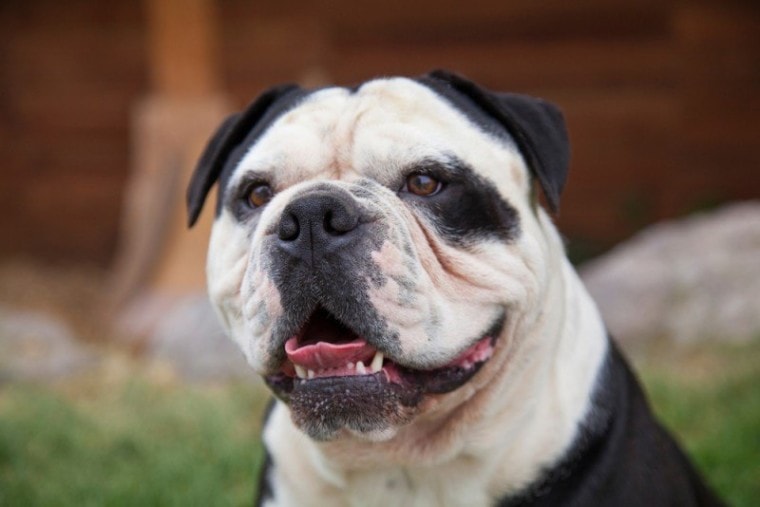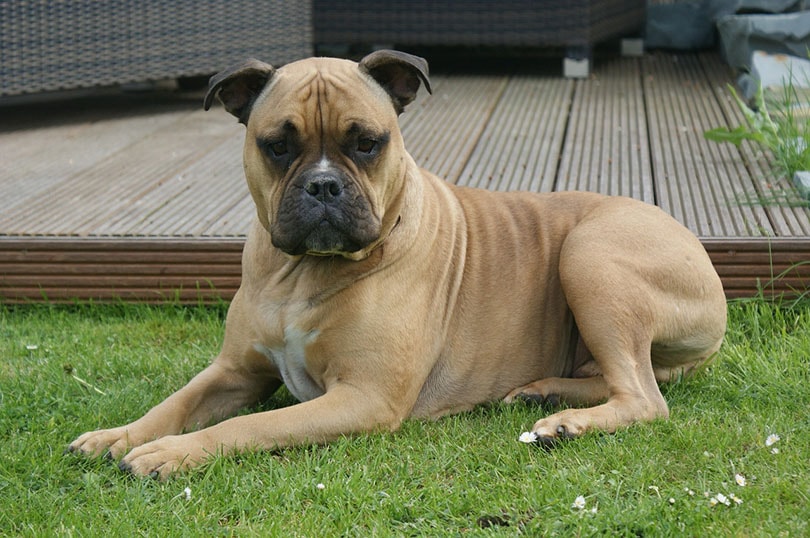
Click Below to Skip Ahead
Although sometimes confused, the Olde English Bulldogge is a separate breed to the English Bulldog or British Bulldog, although the two are obviously closely related. The Olde English Bulldogge tends to be a little taller and can grow heavier than the original Bulldog, and it is free from the facial wrinkles and some other congenital defects that have been bred into its English counterpart. These changes were intentional and were introduced to the line by Pennsylvania-based breeder David Leavitt.
Breed Overview
Height:
16 – 20 inches
Weight:
50 – 80 pounds
Lifespan:
9 – 14 years
Colors:
Red, fawn, black, white
Suitable for:
Families and individuals looking for a loyal and loving companion
Temperament:
Friendly, Loving, Confident, Courageous, Alert
The breed is recognized by the American Kennel Club, as well as other national registries, although it remains a rare breed that is difficult to get hold of.
Although the Olde English is free from many of the congenital health complaints that plague the original English Bulldog, it is still prone to gassiness and excessive drooling and does require a lot of socialization and positive training to get the best out of the rare breed.
Olde English Bulldogge Characteristics

Olde English Bulldogge Puppies

Although it has grown in popularity a little in recent years, the Olde English Bulldogge remains a rare breed. The biggest obstacle to buying one of these breeds, however, remains the difficulty of finding a suitable breeder. Don’t let the scarcity of breeders cause you to choose an unsuitable breeder or a dog that you don’t really want; be prepared to look around and take your time choosing a suitable kennel so you have a better chance of a healthy and well-adjusted dog.Try to choose a breeder that is kennel club registered. If a breeder is signed up to a breed group or kennel club, they agree to adhere to strict standards and guidelines, which include health screening and a limit on the litters that a dog can produce in a single year.
The rarity and cost of this breed mean that you are unlikely to find them in a shelter, but it is possible. Adopting helps protect the dog and can provide an otherwise unwanted pup with a loving, forever home, but it does come with the added challenge that you have no idea of the dog’s background or breeding.
Temperament & Intelligence of the Olde English Bulldogge
The Old English Buldogge is a combination of a loyal guard dog and a loving companion. It can be somewhat stubborn but is eager to please its owners. It is also more adaptable than the original English Bulldog, which means that it can live in an apartment, although it will need regular exercise to ensure that it remains fit and healthy, but is it suitable for your family?
Are These Dogs Good for Families? 👪
The breed is known to be loving and affectionate and will bond with all members of the family regardless of their age and whether they are the main feeder or not. Their playfulness and energy mean that they are especially good for older children that can throw a ball around or pull a piece of rope. Some care needs to be taken with smaller children because these are muscular and strong dogs. They are capable of causing injury even by accident, and especially when they get excited.
Does This Breed Get Along with Other Pets?

The Bulldogge tends to get along with other dogs in their own home, although they can be same sex aggressive with bigger dogs that they meet outside the home. Always take new introductions slowly and be sympathetic to your dogs’ needs. The breed is not a hunter so should not have much of a predatory instinct. It can, therefore, be housed with cats, if it has been socialized as a puppy and young dog. As with small children, there is a danger of the big Bulldogge causing accidental injuries to smaller dogs and animals, so do be careful in this regard.

Things to Know When Owning an Olde English Bulldogge:
The Old English Bulldogge can make a great family pet and is considered loving and loyal with all of its family members. However, similar breeds are known for their health problems and for problems like drooling and loud breathing. But does the Olde English suffer similar problems? Read on for more details of what you need to know when taking one of these big dogs into your family and to determine whether it is the right choice of breed for you.
Food & Diet Requirements 🦴
The breed is a big dog and has a big appetite. Although exact amounts will vary by dog, you should expect to feed around three cups of good quality dry kibble a day. They can be prone to putting on weight, so ensure that you have your dog weighed and then feed an appropriate amount according to size, age, activity levels, and any health or dietary requirements. If your vet advises you to feed more or less, follow these guidelines over those that are provided on the food packaging.
The Bulldogge is prone to bloat, which is typically caused when they wolf down too much food in one meal. Feed smaller amounts, more often, to help avoid this painful and potentially fatal problem. If your dog does wolf its food, you can also buy special bowls that are designed to slow their feeding habits down to a healthier speed.
If you use treats for a reward-based training program, don’t forget to take these into account when calculating their daily food intake, or use low-calorie or no-calorie food treats.
As with any breed of dog, you must ensure that yours has access to a steady supply of fresh drinking water.
Exercise 🐕
If you are looking for a dog that is happy to be out, running all day long or one that rarely gets off its bed, you should look elsewhere. The Bulldogge may not have the highest exercise requirements of any breed, but it is prone to bursts of energy and will enjoy its daily walk. Provide a brisk 45-minute walk each day, and supplement this with some time playing in the yard. You can also sign up for agility and other canine sports classes to help give your dog structured exercise. These can also help with training and will form a close bond between you and your pup.
Training 🎾
Eager to please its owner, the Olde English Bulldogge is considered somewhat easy to train. However, it needs to know that you are the leader. Use positive reinforcement, be consistent in your commands, but do not use physical reprimands, and do not scream at your dog when it does something wrong. Positive reinforcement techniques will work well with the Bulldogge when implemented and used appropriately.
Puppy classes are a good idea for young dogs. They give you the tools needed to be able to successfully train the dog as it ages, and they also allow a degree of socialization in a safe environment. Although the breed gets along with strangers, socialization doesn’t hurt and will help ensure a well-rounded and friendly dog that can adapt to new situations.
Grooming ✂️
The breed is considered a low-maintenance dog. Its short coat does not require too much grooming, and you should get away with brushing weekly to remove dead hairs and prevent knotting. While facial folds are less prominent than in some other breeds, if your Olde English does have any, you will need to wipe them and remove dirt regularly to avoid infection. This is especially a problem because this breed is prone to drooling.
You should brush your dog’s teeth at least three times a week and can supplement brushing by feeding hard chews and dental treats that stimulate saliva while brushing plaque away.
Claws also need trimming regularly, typically every two months or so.
Health and Conditions 🏥
Generally, a hardy and healthy breed, there are certain health conditions that the Bulldogge is nevertheless prone to, including:
Male vs Female
The male Olde English Bulldogge will grow taller and weigh more than the female. Although the temperament of the dog is more closely linked to its character, the male can exhibit some aggression towards bigger dogs of the same sex, so you will have to take some care when out walking and socializing.

3 Little-Known Facts About the Olde English Bulldogge
1. They Are One of the Healthier Bulldog Breeds
It might be surprising to learn that there are 9 bulldog breeds: Alapaha Blue-Blood, American, Australian, Ca de Bou, Catahoula, English, French, Victorian, and, of course, the Olde English.
In a lot of cases, the dogs have had certain attributes bred into them, such as the short snout and the facial folds. Some of these were popular for practical reasons but many have been instilled into the breed’s line because of their aesthetic appeal. Unfortunately, some of these traits, such as the short snout, also come with some serious health complaints. The short snout can cause breathing problems, for example, while the facial folds are prone to bacterial and other infections.
The Old English Bulldogge was intentionally bred so that it did not share the potentially unhealthy traits of the English Bulldog and, as such, it has less chance of suffering congenital illnesses and conditions. However, you should be aware that the breed is still prone to bloat, so you should feed smaller meals more ofte to avoid overfeeding.
2. They Make Good Family Pets
Another reason behind the original Olde English Bulldogge was to create a similar-looking and similar behaving breed that would make a better all-around pet. Again, the breeding program was successful, and while the English Bulldog can make an excellent family pet, the Olde English is known to be friendlier. It also adapts to new situations and new people better than the original.
If you want an adaptable dog that is still loyal and somewhat protective, this is a good choice of breed for your home.
3. They Are Sometimes Described as Hypoallergenic
All dogs give off some allergens, and even those with a short coat that does not shed, like the Olde English Bulldogge will still cause an allergic reaction in some sufferers. This is especially true of the Bulldogge because of its propensity to drool a lot.
Dog drool contains a protein that acts as an allergen in sufferers. However, where the Buldogge has the upper hand over a lot of other breeds is in its coat. The breed does not shed much, has a short coat, and produces minimal dander, so while it can still trigger an allergic reaction, it is less likely with this breed than with most others.

Final Thoughts
The Olde English Bulldogge is a separate breed to the English Bulldog, but as it stems from that breed, there are obviously some similarities. This rarer breed is taller and not as stocky as the English, and it does not have as short a snout or as many facial wrinkles. This means that it will not usually breathe as heavily or suffer the same breathing difficulties. The Olde English was also bred so that it did not have any aggressive qualities, so while it is a loyal and loving dog, with good socialization, you should have no problems introducing it to new people or new situations.
Because it mixes well with children and strangers and can usually live happily with other dogs and even cats, this is a good choice of a family dog breed.
You may also want to read:
- 10 Best Dog Foods for English Bulldogs– Reviews & Top Picks
- American Bully XL: Pictures, Facts, & History

Featured Image Credit: Jaden Cardona Photography, Shutterstock






